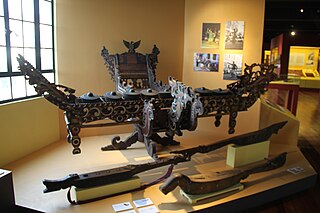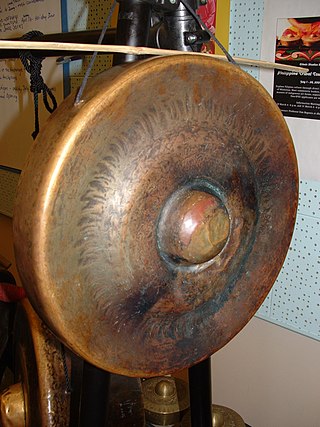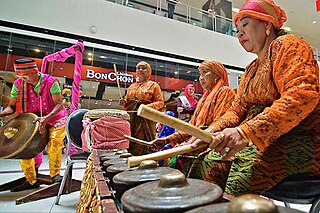Related Research Articles

The xylophone is a musical instrument in the percussion family that consists of wooden bars struck by mallets. Like the glockenspiel, the xylophone essentially consists of a set of tuned wooden keys arranged in the fashion of the keyboard of a piano. Each bar is an idiophone tuned to a pitch of a musical scale, whether pentatonic or heptatonic in the case of many African and Asian instruments, diatonic in many western children's instruments, or chromatic for orchestral use.

Lanao del Sur, officially the Province of Lanao del Sur, is a province in the Philippines located in the Bangsamoro Autonomous Region in Muslim Mindanao (BARMM). The capital is the city of Marawi, and it borders Lanao del Norte to the north, Bukidnon to the east, and Maguindanao del Norte and Cotabato to the south. To the southwest lies Illana Bay, an arm of the Moro Gulf.

South Cotabato, officially the Province of South Cotabato, and since 2019, South Cotabato was renamed in the Province as Cotabato del Sur , is a province in the Philippines located in the Soccsksargen region in Mindanao. Its capital is Koronadal, and it borders Sultan Kudarat to the north and west, Sarangani to the south and northeast, and Davao del Sur to the far northeast. To the southeast lies Sarangani Bay.

Kulintang is a modern term for an ancient instrumental form of music composed on a row of small, horizontally laid gongs that function melodically, accompanied by larger, suspended gongs and drums. As part of the larger gong-chime culture of Southeast Asia, kulintang music ensembles have been playing for many centuries in regions of the Southern Philippines, Eastern Malaysia, Eastern Indonesia, Brunei and Timor, Kulintang evolved from a simple native signaling tradition, and developed into its present form with the incorporation of knobbed gongs from Sundanese people in Java Island, Indonesia. Its importance stems from its association with the indigenous cultures that inhabited these islands prior to the influences of Hinduism, Buddhism, Islam, Christianity or the West, making kulintang the most developed tradition of Southeast Asian archaic gong-chime ensembles.

The suling is a musical instrument of the Sundanese people in Indonesia. It is used in the Degung ensemble. Bamboo ring flute can also be found in Southeast Asian, especially in Brunei, Indonesia, Malaysia, the Philippines and Singapore.

A slit drum or slit gong is a hollow percussion instrument. In spite of its often being called a drum, it is not a true drum because it lacks a drumhead, the membrane stretched across the top of a true drum. It is classed instead as an idiophone in which the entire instrument vibrates.

The agung is a set of two wide-rimmed, vertically suspended gongs used by the Maguindanao, Maranao, Sama-Bajau and Tausug people of the Philippines as a supportive instrument in kulintang ensembles. The agung is also ubiquitous among other groups found in Palawan, Panay, Mindoro, Mindanao, Sabah, Sulawesi, Sarawak and Kalimantan as an integral part of the agung orchestra.

The babandil is a single, narrow-rimmed Philippine gong used primarily as the “timekeeper” of the Maguindanao kulintang ensemble.

The kulintang a kayo is a Philippine xylophone of the Maguindanaon people with eight tuned slabs strung horizontally atop a padded wooden antangan (rack). Made of hand-carved soft wood such as bayug or more likely tamnag, the kulintang a kayo is rarely found except in Maguindanaon households which have a strong kulintang musical heritage. Traditionally, this homemade instrument was used for self-entertainment purposes inside the house, so that beginning musicians could practice kulintang pieces before performing them on the full-sized metal kulintang sets. Only recently have these instruments been used as part of a wooden kulintang ensemble. This ancient instrument is considered to have existed in the Philippines before the importation of metal gongs from China and therefore is considered a precursor to the present-day kulintang.

The kubing is a type of Philippine jaw harp from bamboo found among the Maguindanaon and other Muslim and non-Muslim tribes in the Philippines and Indonesia. It is also called kobing (Maranao), kolibau (Tingguian), aru-ding (Tagbanwa), kuribaw, aribao (Isneg), aroding (Palawan), kulaing (Yakan), ulibaw (Kalinga), karombi (Toraja), yori (Kailinese) or Kulibaw. Ones made of sugar palm-leaf are called karinta (Munanese), ore-ore mbondu or ore Ngkale (Butonese).
The kutiyapi, or kudyapi, is a Philippine two-stringed, fretted boat-lute. It is four to six feet long with nine frets made of hardened beeswax. The instrument is carved out of solid soft wood such as that from the jackfruit tree.

The Yakan people are among the major Filipino ethnolinguistic groups in the Sulu Archipelago. Having a significant number of followers of Islam, it is considered one of the 13 Muslim groups in the Philippines. The Yakans mainly reside in Basilan but are also in Zamboanga City. They speak a language known as Bissa Yakan, which has characteristics of both Sama-Bajau Sinama and Tausug. It is written in the Malayan Arabic script, with adaptations to sounds not present in Arabic.
The Culture of Basilan are derived from the three main cultural ethnolinguistic nations, the Yakan, Suluanon Tausug and the Zamboangueño in the southern Philippines. Both Yakans and Tausugs are predominantly Muslim, joined by their kin from the Sama, Badjao, Maranao, and other Muslim ethnolinguistic groups of Mindanao, while the Zamboangueños are primarily Christian, joined by the predominantly Christian ethnolinguistic groups; the Cebuano, Ilocano, Tagalog and others. These three main groups, however, represent Basilan's tri-people or tri-ethnic group community.

Philippine traditional musical instruments are commonly grouped into four categories: aerophones, chordophones, membranophones, and idiophones.

Bamboo's natural hollow form makes it an obvious choice for many musical instruments. In South and South East Asia, traditional uses of bamboo the instrument include various types of woodwind instruments, such as flutes, and devices like xylophones and organs, which require resonating sections. In some traditional instruments bamboo is the primary material, while others combine bamboo with other materials such as wood and leather.

The Kalagan are a subgroup of the Mandaya-Mansaka people who speak the Kalagan language. The Kalagan comprise three subgroups which are usually treated as different tribes: the Tagakaulo, the Kagan, and the Kal’lao people of Samal. They are native to areas within Davao del Sur, Compostela Valley, Davao del Norte, Davao Oriental, and North Cotabato; between the territories of the Blaan people and the coastline. They were historically composed of small warring groups. They are renowned as agriculturalists, cultivating rice, corn, abaca, and coconut for cash crops, whereas their counterparts living along the coast practice fishing.

The gabbang, also known as bamboo xylophone, is a musical instrument made of bamboo widely used in southern Philippines. Among the Tausugs and Samas, it is commonly played to accompany songs and dances as a solo instrument or accompanied by the biola.

Ramón Pagayon Santos is a Filipino composer, ethnomusicologist, and educator known for being the Philippines' foremost living exponent of contemporary Filipino classical music, for work that expounds on "the aesthetic frameworks of Philippine and Southeast Asian artistic traditions," and for finding new uses of indigenous Philippine instruments.

Uwang Ahadas was a Filipino folk musician of the Yakan people who was a recipient of the National Living Treasures Award.
References
- ↑ Mercurio, Philip Dominguez (2006). "Traditional Music of the Southern Philippines". PnoyAndTheCity: A center for Kulintang - A home for Pasikings. Retrieved June 12, 2006.
- ↑ de la Paz, Salve (2006). "Gawad sa Manlilikha ng Bayan - 2000 Awardee - UWANG AHADAS - Creating a Legacy of Music". National Commission For Culture and the Arts. 2002. National Commission For Culture and the Arts. Retrieved June 12, 2006.